Carmen ... Revisited
by Les Hansen
Issue No. 389 - October 2005
Carmen, Cambridge's name for its ruby-colored glass, might top the list among Cambridge colors for popularity among collectors today. Yes, there are those who are devoted to Royal Blue, and Heatherbloom has a big following. Mardi Gras is very hard to find, so solicits many oohs and aahs. Numerous opaque colors, especially Crown Tuscan, Violet, and decorated ivory, have their share of admirers.
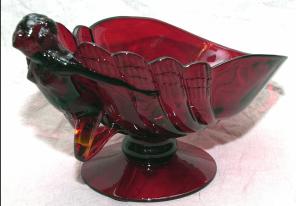 However, if a poll of Cambridge collectors were taken in which
colors were ranked for desirability, I suspect Carmen would rank #1 (or
very nearly so). Carmen is indeed a beautiful color for glassware, and
the Colors in Cambridge Glass book states that Carmen is 'a
rich full bodied red that does not bear the depth of color or hardness
of appearance that is often found in the ruby colors of other glass
companies'. Some items in Carmen lean toward yellow, especially in
areas of items with thinner glass. Other items in Carmen are extremely
deep, to the point of bordering on opaque, in the areas of items with
thicker glass.
However, if a poll of Cambridge collectors were taken in which
colors were ranked for desirability, I suspect Carmen would rank #1 (or
very nearly so). Carmen is indeed a beautiful color for glassware, and
the Colors in Cambridge Glass book states that Carmen is 'a
rich full bodied red that does not bear the depth of color or hardness
of appearance that is often found in the ruby colors of other glass
companies'. Some items in Carmen lean toward yellow, especially in
areas of items with thinner glass. Other items in Carmen are extremely
deep, to the point of bordering on opaque, in the areas of items with
thicker glass.
We last discussed Carmen in the March 2002 (#359) issue of the Crystal Ball. In that article, we pointed out that all of the transparent colors of Cambridge glass in the 1930s were priced the same, except Carmen was priced 50% to 100% higher than the other colors. In other words, Carmen commanded a premium price when it was originally made, and it continues to command a premium price today compared to other Cambridge glass colors.
Old stories die hard. A good, but false, story is that Carmen glass
contains gold. We pointed out in the March 2003 article that Carmen is
a selenium-based ruby glass. We know definitely from Henry Hellmers'
Batch Book of Glass Formulae published in 2002 by Bill
Courter, that none of the numerous formulas for Carmen contained gold.
Perhaps a gold coin was tossed into a single batch of Carmen at some
point (that's how the story goes), but Carmen clearly was a
selenium-based ruby glass and not a gold-based ruby glass. Glass
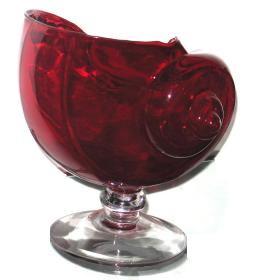 manufacturers in the 1930s (Carmen was re-introduced for a period of
time in the 1950s) such as Cambridge simply could not afford to use
gold as a raw material.
manufacturers in the 1930s (Carmen was re-introduced for a period of
time in the 1950s) such as Cambridge simply could not afford to use
gold as a raw material.
The coloring agents in Carmen, were cadmium sulfide (yellow - when glass is reheated) and selenium (red when glass is reheated). Actually, the general formula for Carmen is very simple - just the four base materials of sand, soda, potash and lime - plus borax, zinc oxide, and the two coloring agents of cadmium sulfide and selenium. Some have conjectured that the raw materials for Carmen might have been expensive, and this might explain the higher cost of Carmen compared to other transparent colors. That was probably not the case. Others have conjectured that Carmen was "brittle" and difficult to remove from molds; hence many items might have been rejected, ground, and used as cullet in future batches of Carmen. That was probably not the case. either.
There certainly was a high rejection rate of Carmen items at the Cambridge factory, because more than 50% of numerous formulas for Carmen are composed of cullet - reused glass of the same color. However, the high rejection rate was most likely due to the difficulty in getting the color just right when originally melting the raw materials in the pot and while reheating individual items. Carmen items weren't their distinctive red color when they originally came out of the molds, because they needed to be partially cooled and then reheated to bring out the Carmen color. This was a difficult process to get just right -- reheating too little or too much were both problematic.
The book Modern Glass Practice, by Scholes and Greene, states that making selenium-based ruby glass is "more of an art than a science." Ideal melting conditions are critical to make selenium-based ruby glass, and the raw materials needed to be added to a preheated pot. Add to this the difficulty of length of time for reheating of individual items, and it is not surprising that perhaps up to one half of Carmen items produced by Cambridge were rejected and recycled as cullet at the factory.
The following photographs show some of the many Cambridge items made in Carmen:
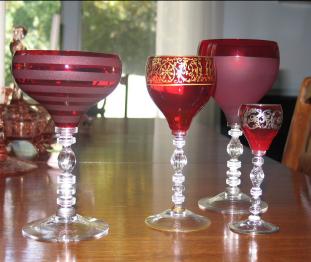
Carmen Stemware: Yukon, Gold Silkscreen
Partial Frosted, Silver overlay
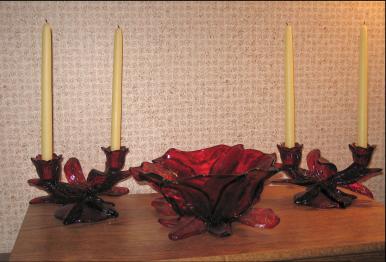
Carmen Everglades Console Set
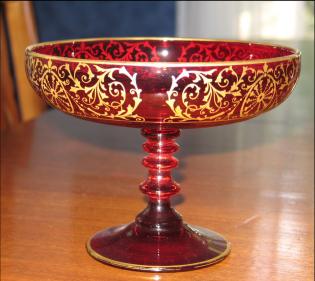
Carmen Tally-Ho gold decorated comport
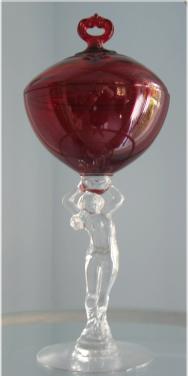
Carmen 3011 Sweetmeat
